|
|
|
Sort Order |
|
|
|
Items / Page
|
|
|
|
|
|
|
| Srl | Item |
| 1 |
ID:
110052


|
|
|
|
|
| Publication |
2011.
|
| Summary/Abstract |
This article is a discussion of current trends in China's growing foreign economic ties and its place in the international division of labor.
|
|
|
|
|
|
|
|
|
|
|
|
|
|
|
|
| 2 |
ID:
132592
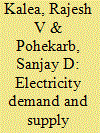

|
|
|
|
|
| Publication |
2014.
|
| Summary/Abstract |
Forecasting of electricity demand has assumed a lot of importance to provide sustainable solutions to the electricity problems. LEAP has been used to forecast electricity demand for the target year 2030, for the state of Maharashtra (India). Holt's exponential smoothing method has been used to arrive at suitable growth rates. Probable projections have been generated using uniform gross domestic product (GDP) growth rate and different values of elasticity of demands. Three scenarios have been generated which include Business as Usual (BAU), Energy Conservation (EC) and Renewable Energy (REN). Subsequent analysis on the basis of energy, environmental influence and cost has been done. In the target year 2030, the projected electricity demand for BAU and REN has increased by 107.3 per cent over the base year 2012 and EC electricity demand has grown by 54.3 per cent. The estimated values of green house gas (GHG) for BAU and EC, in the year 2030, are 245.2 per cent and 152.4 per cent more than the base year and for REN it is 46.2 per cent less. Sensitivity analysis has been performed to study the effect on the total cost of scenarios. Policy implications in view of the results obtained are also discussed.
|
|
|
|
|
|
|
|
|
|
|
|
|
|
|
|
| 3 |
ID:
127998


|
|
|
|
|
| Publication |
2014.
|
| Summary/Abstract |
Sustainability is fundamentally a challenge of tradeoffs. In order to improve human well-being through economic development we consume nonrenewable energy and other natural resources, relying on a broad range of ecosystem services. Enhancing sustainability requires reducing the "energy intensity of human well-being (EIWB)": the amount of energy used per unit of human well-being. In this study we employ longitudinal analysis techniques to assess the temporally dynamic relationship between EIWB and economic development for a sample of 12 Central and Eastern European (CEE) nations for the 1992 to 2010 period. These are nations that have recently transitioned, which is still an ongoing process, from socialist command economies to market demand economies. During this ongoing transition, many of them have experienced declines in energy intensity, coupled with increased energy efficiency, while human well-being has improved considerably. The results of the analysis indicate that the relationship between EIWB and economic growth in CEE nations is complex and has changed dramatically through time. Of particular importance, the later years of the study exhibit an increasingly sustainable relationship between EIWB and economic development. The findings point to future possibilities for relatively more harmonious relationships between development, human well-being, and the natural environment.
|
|
|
|
|
|
|
|
|
|
|
|
|
|
|
|
| 4 |
ID:
129378
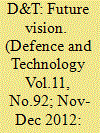

|
|
|
|
|
| Publication |
2012.
|
| Summary/Abstract |
The global aircraft manufacturer Airbus has released the latest installment of the future by airbus, its vision for sustainable aviation in 2050 and beyond. for the first time the vision looks beyond aircraft design to how the aircraft is operated both on the ground and in the air in order to meet the expected growth in air travel in a sustainable way.
|
|
|
|
|
|
|
|
|
|
|
|
|
|
|
|
| 5 |
ID:
124543
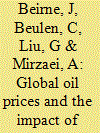

|
|
|
|
|
| Publication |
2013.
|
| Summary/Abstract |
This paper assesses the externality impact of China's excessive growth as a China factor on the world economy via examining the effect of Chinese GDP growth on oil prices as a case for the issue. Our assessment starts, firstly, by estimating a country-level demand model to determine the GDP influences of an individual country on oil demand. Secondly, it estimates the impact of world aggregate demand on oil prices. This two-stage approach enables us to estimate the effect of the GDP growth of an individual nation on oil demand globally and the global price of oil. The estimated demand model is applied to quantify the effect of the Chinese GDP growth on the price of oil through simulations of a range of scenarios for each year over the period 2009 to 2030. We find that China's excessive growth adds a premium to the price of oil which increases over time. The results have policy implications in terms of the sustainability of the Chinese faster growth rate from the perspective of its negative externalities to the world.
|
|
|
|
|
|
|
|
|
|
|
|
|
|
|
|
| 6 |
ID:
088151


|
|
|
|
|
| Publication |
2009.
|
| Summary/Abstract |
THE WORLD HAS COME TO THE LINE beyond which there are changes, probably much more radical than those of the late 1980s. The financial and economic crisis that in some countries is developing into a political one made this abundantly clear to the expert and analyst communities; political establishment, too, has finally arrived to the same conclusion: election of Barack Obama confirms this. The energy of liberalism swept aside, under the "end of history" banner, the dividing walls, regimes, social and cultural models, ethnic traditions of national economies, ideologies and even the efforts to sort out the developments giving no chance to those who tried to find other, better ways of civilizational development. This tactics can no longer be used.
|
|
|
|
|
|
|
|
|
|
|
|
|
|
|
|
| 7 |
ID:
163570
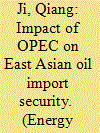

|
|
|
|
|
| Summary/Abstract |
East Asian countries, such as China, Japan and South Korea, are major importers in the international oil market. Therefore, oil import security is critical to sustainable economic development in these countries. This paper uses a modified two-stage DEA-like model to investigate the impact of the Organization of Petroleum Exporting Countries (OPEC) on oil import security in the East Asian region over time. Specifically, three dimensional variables were introduced to the model: the OPEC internal dimension, the OPEC and Asian country interaction dimension, and the international external dimension. The empirical results show a substantial difference between China and the other two countries in terms of these dimensions. Although the impact of OPEC on China's oil security has increased over time, its impact on Japan has declined. Political uncertainty in OPEC countries and oil price volatility are the major issues for China, whereas cost is the key area of concern for Japan. South Korea's concerns are less clear. The results of this study lay an important foundation for discussing policy issues involved in regional cooperation, integration and sustainable growth in the East Asian region.
|
|
|
|
|
|
|
|
|
|
|
|
|
|
|
|
| 8 |
ID:
111560


|
|
|
|
|
| Publication |
2011.
|
| Summary/Abstract |
In the new century, Latin America and the Caribbean has gradually upgraded its economic vigor and maintained a good momentum, thus laying a solid foundation for Latin America's economy. Having appropriately coped with the shocks of the international financial crisis, Latin America enjoys a favorable situation in dealing with the current external economic risks. Despite the impact of its internal structural problems and external macro environment, economic development in Latin America enjoys a favorable future. The "China factor" is playing an increasingly important role in the development of Latin America's economy. Looking ahead, China and Latin America will highly likely expand mutually complementary advantages in their economy and trade, in that the Chinese market will provide favorable external conditions for the sustainable growth of Latin America's economy and Latin American countries will in return provide more room for developing China's foreign trade and investment. More closely intertwined and integrated interests between China and Latin America represents the trend of times. It conforms to the fundamental interests of both sides to steer Sino-Latin American cooperation to a comprehensive, in-depth and sustainable development.
|
|
|
|
|
|
|
|
|
|
|
|
|
|
|
|
| 9 |
ID:
132616


|
|
|
|
|
| Publication |
2014.
|
| Summary/Abstract |
Energy lies at the backbone of any advanced society and constitutes an essential prerequisite for economic growth, social order and national defense. However there is an Achilles heel to today×s energy and technology relationship; namely a precarious intimacy between energy and the fiscal, social, and technical systems it supports. Recently, widespread and persistent disruptions in energy systems have highlighted the extent of this dependence and the vulnerability of increasingly optimized systems to changing conditions. Resilience is an emerging concept that offers to reconcile considerations of performance under dynamic environments and across multiple time frames by supplementing traditionally static system performance measures to consider behaviors under changing conditions and complex interactions among physical, information and human domains. This paper identifies metrics useful to implement guidance for energy-related planning, design, investment, and operation. Recommendations are presented using a matrix format to provide a structured and comprehensive framework of metrics relevant to a system×s energy resilience. The study synthesizes previously proposed metrics and emergent resilience literature to provide a multi-dimensional model intended for use by leaders and practitioners as they transform our energy posture from one of stasis and reaction to one that is proactive and which fosters sustainable growth.
|
|
|
|
|
|
|
|
|
|
|
|
|
|
|
|
| 10 |
ID:
190395


|
|
|
|
|
| Summary/Abstract |
This essay focuses on three broad sets of issues that may not slow China's GDP growth to under 3 percent a year, but they will almost certainly create major social and physical problems that will be difficult to deal with. The first is the demographic and education challenges featured by a rapidly aging population combined with a large share of the population being under-educated. The second is the environmental challenges China faces in achieving the state goal of carbon neutrality by 2060. The third challenge is low consumption and unprecedentedly high investment, a strategy that has driven China's high growth rates in the past decades but is no longer sustainable. These three challenges are intertwined, making China's adjustment path even more uncertain. What would a sustainable development strategy involve? The clearest need is to shift investment away from energy-intensive housing and infrastructure and toward investment in people.
|
|
|
|
|
|
|
|
|
|
|
|
|
|
|
|
| 11 |
ID:
076907
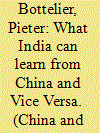

|
|
|
| 12 |
ID:
180359


|
|
|
|
|
| Summary/Abstract |
This paper assesses the strategies of the United Arab Emirates (UAE) to instill leadership values and to encourage youth to take leadership roles as a solution for the future sustainable economic growth. In recent years, the UAE government has stepped up initiatives to encourage the Emirati youth to become leaders, as seen in the establishment of, among others, the UAE Youth Global Initiative, the Ministry of Youth Affairs, the Emirates Youth Council, the National Youth Agenda, and the UAE Youth Programme launched under the UAE Government Leaders Programme (UAEGLP). Such steps are accompanied by country’s support for high quality education on a tertiary level available to every citizen willing to pursue their education. This article examines in what ways such attempts at social engineering may provide solutions to the country’s future needs and serve as a model abroad. The research was conducted using data collected from governmental agencies, and interviews with representatives of youth government initiatives.
|
|
|
|
|
|
|
|
|
|
|
|
|
|
|
|
|
|
|
|
|